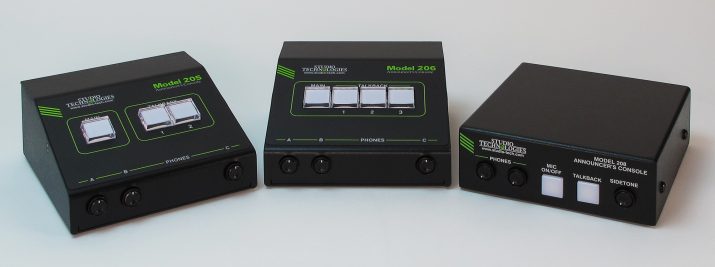NAB 2018: Studio Technologies To Introduce New On-Air Capabilities
Studio Technologies expands its Dante compatible offerings at NAB 2018 with three new announcer’s consoles, the Model 205, Model 206, and Model 208.
All offer combinations of analog and digital audio resources to create on-air talent hubs that deliver audio in both Dante audio-over Ethernet and traditional analog audio environments. The units’ diverse audio resources and small size enable the creation of on-air positions where space is at a premium, making them ideal for sports and entertainment TV, and radio events as well as streaming broadcasts. The Model 205 and Model 206 are specifically designed for table-top use, presenting a very small “footprint” for applications such as court-side basketball commentator locations. The Model 208 is optimized to allow easy mounting to the top- or bottom-surface of a broadcast set or talent location. Its form-factor also lends itself for use in a range of custom mounting scenarios.
 “The broadcast community at NAB is the perfect audience for us to introduce our latest products for use by on-air talent and production personnel,” says Gordon Kapes, president of Studio Technologies. “The design focus for these units was their physical size, needing to be extremely compact for broadcast applications, such as live-sports, where physical space for personnel is limited. But, of course, they still had to provide strong technical performance and a solid user experience. I feel we met our goals with the Models 205, 206, and 208, which in addition to their small size, are extremely simple to deploy and offer lots of configuration choices by way of our ST controller software application. Using Dante was the natural choice for maintaining audio quality, providing signal routing flexibility, and supporting interconnection efficiency.”
“The broadcast community at NAB is the perfect audience for us to introduce our latest products for use by on-air talent and production personnel,” says Gordon Kapes, president of Studio Technologies. “The design focus for these units was their physical size, needing to be extremely compact for broadcast applications, such as live-sports, where physical space for personnel is limited. But, of course, they still had to provide strong technical performance and a solid user experience. I feel we met our goals with the Models 205, 206, and 208, which in addition to their small size, are extremely simple to deploy and offer lots of configuration choices by way of our ST controller software application. Using Dante was the natural choice for maintaining audio quality, providing signal routing flexibility, and supporting interconnection efficiency.”
The Model 205, Model 206, and Model 208 include Dante receiver (audio input) channels to supply the user with talent cue (IFB) signals. Should the cue signal be “mix-minus,” an integrated sidetone function provides a microphone confidence signal. The Model 205 features three Dante audio output channels, one designated as main (for on-air) and two as talkback, as well as three associated pushbutton switches for direct control over audio routing. The Model 206 adds an additional talkback button and associated Dante audio output channel, making it well-suited for both on-air and production support applications. The Model 208 is designed with two Dante audio output channels, one designated as main (for on-air) and the other as a talkback, as well as two pushbutton switches. All three units have talkback audio channels available as Dante outputs, allowing for simple and flexible routing to inputs on a variety of devices such as matrix intercom systems, audio consoles, and monitor loudspeaker systems. The audio switching is performed in the digital domain and is virtually “click-free.”
Seamless integration into both Dante audio-over-Ethernet applications and standard analog audio environments allows the Model 205, Model 206, and Model 208 to provide a flexible solution for many on-air talent locations. With just a Power-over-Ethernet (PoE) connection, a microphone, and a pair of headphones or an earpiece, broadcasters can use the units to achieve a complete broadcast on-air position. A microphone output on each of the announcer’s consoles can support a direct connection to an analog microphone-level input on an associated camera, remote I/O interface, or audio console. The Model 205 and Model 206 provide two configurable remote-control inputs, allowing external switches or contact closures to activate the desired main and talkback output functions. Two contact inputs on the Model 208 allow external signals to work in conjunction with the mic on/off button and talkback button functions.
Using a low-noise, wide dynamic-range microphone preamplifier and associated voltage-controlled-amplifier (VCA) dynamics controller (compressor) ensures that the Model 205, Model 206, and Model 208’s microphone input audio quality is preserved. The output of the mic preamp and compressor is routed to an analog-to-digital conversion (ADC) section. The three units support a sampling rate of 44.1 and 48 kHz with a bit depth of up to 24. In addition, the Model 208 supports sampling rates of 88.2 and 96 kHz. The audio signal, now in the digital domain, is routed through a microprocessor and onto the Dante interface section where the audio is packetized and prepared for transport over Ethernet.
“Our underlying goal when designing these units was to create dependable, space-conscious on-air solutions that didn’t sacrifice audio quality,” says Kapes. “The ‘205, ‘206, and ‘208 use well-tested circuit designs and rugged components to ensure long, reliable delivery of excellent audio. When used in both Dante and analog environments, broadcasters can be assured that audio signals will have low distortion, low noise, and sufficient headroom.”
A key feature of the Model 205, Model 206, and Model 208 are their ability to be configured using the STcontroller Application, a PC application that enables users to quickly confirm and revise selected parameters. There are no mechanical switch settings or button-press sequences required to configure the units. Selectable parameters include microphone preamplifier gain, P48 phantom power on/off, button operation, remote control inputs, headphone output mode, sidetone operation, and overall unit operation. STcontroller is compatible with Windows 7 and later of the operating system and is used to configure a growing number of Studio Technologies’ Dante-compatible products.
